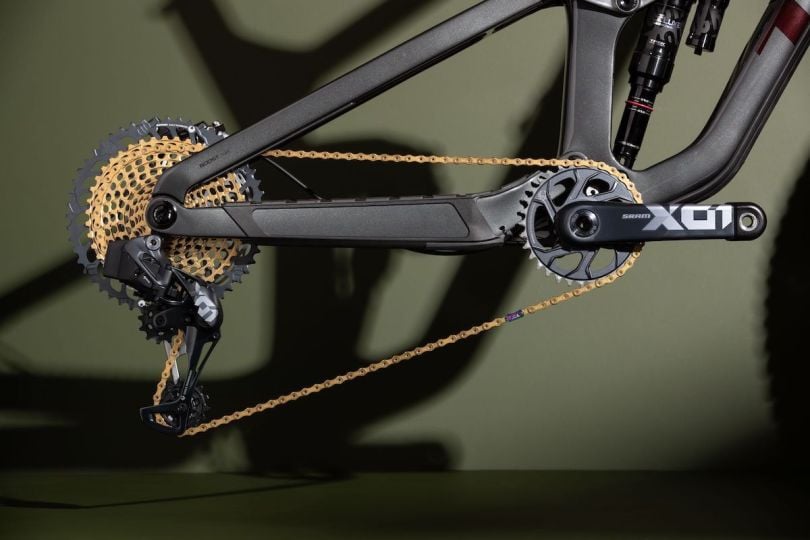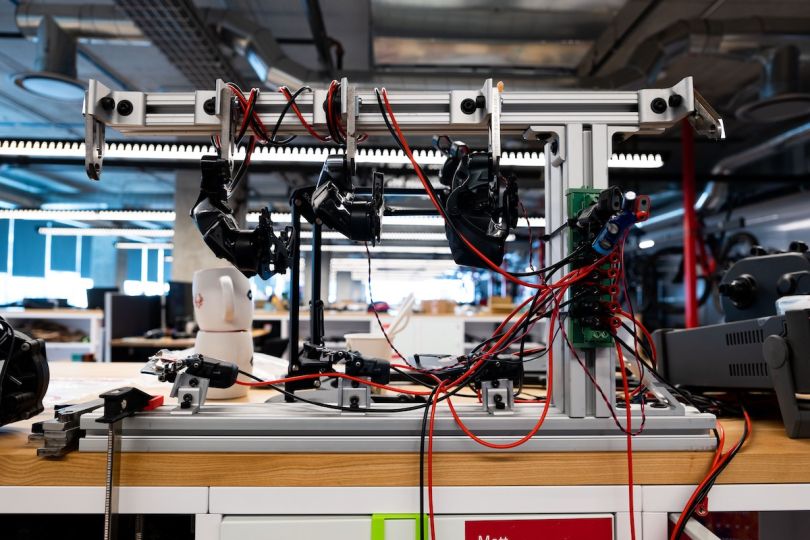As a cyclist, Alan Fischer had thought about tire pressure before.
But it wasn’t until he started developing SRAM’s TyreWiz, a wireless tire pressure sensor, that Fischer, a software engineering manager, quickly learned just how important tire pressure is.
Temperature, elevation changes and the terrain of a trail can affect tire pressure, which in turn can impact the ride, especially when it comes to cornering. When the pressure is too high, there’s less grip, which means cyclists have to slow down to take on tight corners. Or, they risk going too fast and losing grip and confidence.
The first time Fischer used the finished product on a trail he’d ridden many times before, he was noticeably faster. Since then, TyreWiz has been Fischer’s favorite product.
What SRAM Does
SRAM, founded in Chicago in 1987 to create more fun, efficient and faster cycling experiences, builds bicycle components like shifters, derailleurs, brakes, chains, suspension and power meters. Today, SRAM is making its mission digital. Its AXS system connects electronic bike components with software, which helps cyclists control, personalize and measure their riding experience.
Radhika Cherukuru, digital product manager at SRAM and a self-described novice rider, can’t discern tire pressure on her bike with a simple squeeze like more seasoned riders can. Cherukuru doesn’t want any surprises when she embarks on a ride, and products like TyreWiz help her to feel more confident, along with SRAM’s tire pressure guide.
“I can’t lug that 50-pound bike back,” Cherukuru said. “I’d need to call my husband to pick me up.”
TyreWiz is just one of SRAM’s connected tech products that are revolutionizing how cyclists ride their bikes. The device connects directly to the air valve on bike tires, and using Bluetooth technology, it relays the pressure to the SRAM AXS app. Cyclists can enter information about the trail, environmental conditions and tire type, and the app will then recommend the best tire pressure.
According to Cherukuru, TyreWiz is also one of the nearly endless possibilities of how connected tech can enhance the industry.
“There is a huge opportunity for what connected tech can do,” Cherukuru said. “We need to be very judicious. Our goal is to identify what riders want, how they use these connected components on their bike and how that enhances their experience on the bike.”
What riders get out of connected tech is more than cutting a corner faster. It’s about insights and feedback that help them take control and make decisions around the ride. With connected components, riders can observe and track metrics like their heart rate, how many times they shifted, what gears they ride in, the terrain or their route.
“Our goal is to identify what riders want, how they use these connected components on their bike and how that enhances their everyday riding style.”
That creates a feedback loop. Cyclists embark on a ride, they capture data, look at it and can then adjust components to enhance their next ride.
“People love that,” Andy Detskas, user experience team manager, said. “It creates more cyclists than there are today. It inspires more people to ride.”

Cyclists just wanna have fun
The current connected landscape is already solving problems that can be as minute as a kink in your day or as serious as safety.
Take the lifecycle of a bike and its components. Previously, cyclists had little insight into how components worked and required maintenance. Now, components talk to the rider and can signal exactly what they are doing and how they are functioning.
“That improves the user experience, and it lifts this veil on maintenance,” Detskas said. “More insight and knowledge into those systems can only benefit the rider. It can alert them if they’ve got a mechanical issue going on and have a safer ride.”
While wireless connectivity helps riders track past rides, it can also help them plan future ones. For example, SRAM hopes to give riders peace of mind about battery life. It’s one of the more exciting, though everyday, aspects of connected tech that goes a long way, allowing riders to see what’s possible given the charge on certain components.
“It helps cyclists plan their rides and what they want to do on those rides,” Detskas said. “Are they planning to ride really far but flat, or really short but high? What does that mean for the batteries? Those are really interesting spaces to play in because it’s about giving them the right intelligence so they can go out with confidence and have fun.”
An Interconnected Hub
The information derived from SRAM’s connected tech will one day live in a central hub: the AXS mobile app. Right now, cyclists can use the app to configure their connected components for personal preference or for accessibility purposes. Fischer, who works on the mobile app, hopes his team will take it from a feature to another ride-enhancing experience. “We're trying to take it to the next level and make it just even more about the rider, not just about the components,” Fischer said.
The user’s voice is in everything
Cherukuru knows what SRAM’s customers are looking for: more control, functionality and information. That in turn will empower them to make the right decisions about their bike and their rides.
“The rider is the center of everything we think about, design and create,” Cherukuru said.
When building products with wireless connectivity, the first step is to figure out what cyclists want. Cherukuru’s team conducts research and seeks perspectives from SRAM employees who are cyclists.
“The rider is the center of everything we think about, design and create.”
They also rely on internal and external feedback channels, like the customer support team and User Voice, a system that customers use to share ideas on what types of tools would be most useful to them. Once the team lands on an idea, they create a concept that they can test from both the technical and user experience perspectives.
“The mindset here is let’s fail fast so that we can learn fast and focus on the solutions that meet customer needs,” Cherukuru said. “That’s our approach: concept, test, iterate and follow that cycle until we are satisfied that we have the right product.”
The engineers who bring product ideas to life work closely across teams. Embedded, mobile and cloud engineers are interconnected in their mission to deliver the desired product experience, and the collaboration between firmware and software teams sets the development process apart, according to Fischer.
And with strong documentation and space to hop on calls to discuss execution, an element of teamwork pervades the engineering teams. Clear and consistent communication goes a long way.
“We’re all trying to make something awesome,” Fischer said. “It helps that engineers are excited about what we’re making.”

Interconnected and inclusive
What makes connected tech awesome isn’t just the information riders can find. It opens the cycling space to new riders who make the community more inclusive.
Wireless connectivity can help people with disabilities customize their bikes. For example, SRAM’s tech allows someone who needs shifting capabilities on one side to set up their bike that way. Or, for those who handcycle, wireless systems mean they can pedal and shift at the same time.
“We’re looking for those opportunities for innovation that can be expanded to a much broader audience.”
Employees can watch as customers use the tools they built to customize their experience in a way that meets their needs and enables them to ride.
“It’s not strict,” Fischer said. “You can mix it up and do whatever you want, there is so much cross-compatibility, and that’s a really key point of the AXS ecosystem. We planned it, but we leave it open and see what people come up with.”
An inclusive space must also be a safe space. There are opportunities for SRAM to add to cycling safety, especially after its acquisition of Hammerhead, which produces a pocket-size cycling computer-head unit that mounts on a bike’s handlebars.
“Safety just comes with the territory,” Detskas said. “It can be as simple as if it is going to be dark when you go, if it is going to be crowded or quiet, or the fitness implications of where you’re going and if you can actually complete that ride.”
A safer space will create a more inclusive community for women. A 2019 U.C. Berkeley study found women’s perceptions of safety is one of the most prevalent factors impacting the gender gap in cycling. Safety solutions can be as simple as tracking, so riders can communicate to their loved ones where they are.
“These solutions can remove those barriers and bring more people into the activity,” Cherukuru said.
SRAM promotes accessibility through simplicity, too. SRAM’s customers range from seasoned cyclists like Fischer to more casual riders like Cherukuru. That simplicity helps to welcome people of all ages to the cycling world.
“The beauty is providing solutions that are simple enough for anybody to use,” Cherukuru said.
As SRAM embarks on its mission to build a more interconnected cycling ecosystem, it intends to broaden its audience. That comes down to the work of its employees who ensure that when the design process begins, foundational research includes people who are not necessarily represented in cycling.
“What we should be doing when we embark on research projects is thinking about age, fitness level, type of rider, gender, orientation — all these different things that make up the human experience,” Detskas said. “Part of the reason we do that is to be inclusive and get diverse perspectives. But you can have a single perspective that may be unique but can benefit many people.
“We’re looking for those opportunities for innovation that can be expanded to a much broader audience.”








